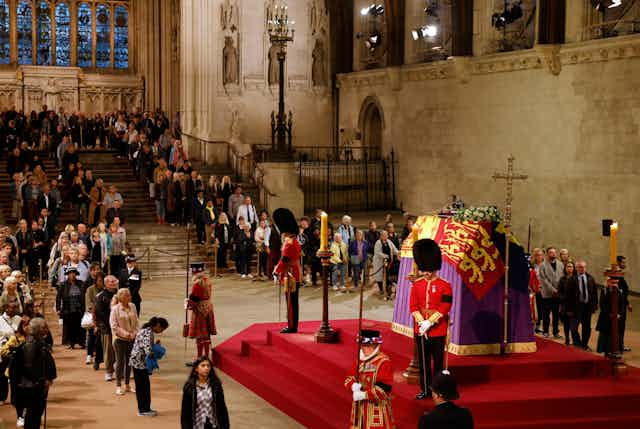The BBC reports that “some of the first mourners to see Queen Elizabeth II lying in state in Westminster Hall have come away in tears, describing the sight of the cloaked coffin as overwhelming”. What is really going on here?
Vast numbers of people do not simply grieve on command. Britain is not North Korea, where the dramatics of hysterical lamentation are switched on and off by official edict. But neither has the outburst of national mourning following the death of the Queen been entirely extemporaneous. Grieving crowds have had to engage with a narrative that has meaning to them, and that narrative has had to be produced, disseminated and refined over time to make it affectively resonant.
The royal narrative has been a long time in the making and, much as many commentators have pointed out that the story of Queen Elizabeth II has defined our age, we might also note that our age of sophisticated public relations and political mood management has shaped it. As the cultural historian Thomas Dixon showed in his wonderful study of crying by the British, when people weep together in moments of collective national feeling “a complex, shared, unconscious, intellectual narrative is running down your cheeks”.
What is it then that people have been crying about in the aftermath of the Queen’s death? Or, if not actually weeping, experiencing quiet feelings of loss and sadness?
In her tribute to the late monarch in the House of Commons, the new prime minister stated that the Queen was “the rock on which modern Britain was built … The United Kingdom is the great country it is today because of her.”
Such massive historical claims deny and defy the complexities of social development. It may be reasonable to state that the late Queen re-invented her role in line with forces of modernity that were going on around her, but even the most ardent monarchist would not suggest that she was personally responsible for bringing them about. Such exaggeration only serves to make the bereaved seem deluded.
And there are plenty of commentators willing to depict those who visibly grieve at moments like this as emotional saps. Former prime minister Boris Johnson characterised the expression of public grief at the time of Princess Diana’s death as “hysteria” and “contagious mourning”.
Apart from its profound condescension towards the people involved, such attempts to pathologise public emotions fail to acknowledge the extent to which membership of a society is not simply a matter of utilitarian interest fulfilment but attachment, shared sentiment and active desire. It is about notions of a stable world; the nurturance and fragility of valued relationships; the delicate interflows between private experience and public existence; the interplay between media representation and personal projection.
The public ‘mood’
We might refer to surges of amorphous, intangible, inarticulable public feeling as mood. I have written elsewhere that “moods force us to encounter the sensorial forms through which historical forces become available to experience”. They are not like rational opinions whereby causes, effects and courses of action are pinpointed, but allude to our sense of who we are and why we care about things. Moods are suggestive. They open us up to possibilities of feeling.

People queuing to see the Queen’s body have told stories to reporters about how this moment of reflection opened up emotional space for them to release buried feelings about losses in their own lives. Rather than thinking of the current display of public passions as “hysteria” or “contagion”, perhaps we should think of it as a moment in which people pose the crucial questions: “What opportunities are available to me for relating to this situation on my own terms? What might be involved in acting upon these feelings that I am barely registering at the moment?”
Surely enough, people’s feelings are going to be put to a tough test in the days to come, as the gap between incomes and the cost of living widens, the insecurities of European war disrupt their lives, and the health services they have always depended upon bear unprecedented strains.
Amid such turmoil, risk and impermanence, the search for reliable constants is perfectly understandable. The monarchist narrative (which to people like me is antithetical to our democratic impulses and preferred stories about the world) will appeal to some and repel others.
More important than which narrative of social cohesion and morality we buy into is the significance of acknowledging the value of emotionally resonant shared narratives. For it is only by creating and sustaining them that we can hope to have any control over what the world means to us and we to it.

